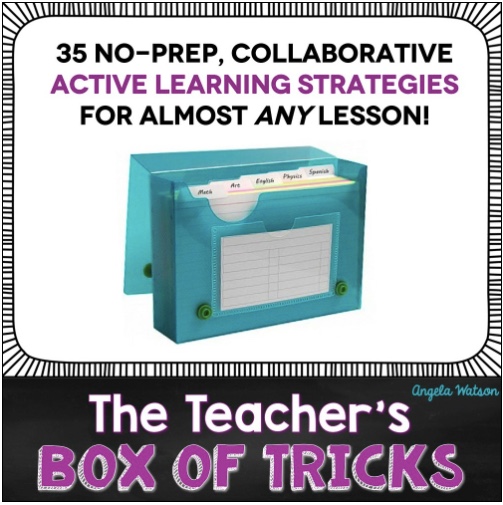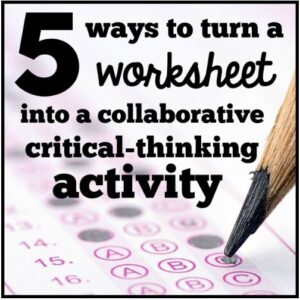5 Ways to Turn a Worksheet into a Collaborative Critical Thinking Activity
Worksheets: we all have to give them, we all hate doing it. Here are 5 no prep ways you can turn just about any lower level thinking or rote practice worksheet (like a multiple choice or fill-in-the-blank quiz, or math drill workbook page) into an activity that’s collaborative and includes higher level thinking skills. The best part? The activities are engaging for kids and FUN.
1. Lines of Communication
Have students stand in two rows facing each other. Choose a question or problem from a worksheet and read it aloud to the class. Give students 30-60 seconds to discuss their responses and reasoning with the person across from them. Give a signal for each student to then move one position to the right (the student without a partner at the end simply walks to the other end to find his or her new partner.) Continue playing until students have discussed all the questions.
Also try:
- giving students an answer, and have them work with their partner to brainstorm possible questions/problems for that answer
* This is similar to Bend the Line.
2. Cut Apart
Group students into teams of five and pass out one copy of the same worksheet to each group. Have the group cut apart the worksheet so each question is on a separate strip or “card.” Students then place the stack face down and choose roles (to be Person 1,2,3,4, or 5.) Explain how the activity is played and write the following team roles on the board for class reference: Person 1 on each team chooses a card and reads the question or problem aloud to the team. Person 2 paraphrases the question and/or offers clues to the answer. Person 3 says the answer and explains his or her thinking. Person 4 explains why he or she agrees or disagrees. Person 5 places the question card in one of two piles, Agree or Disagree, and then takes on the role of Person 1 for a new “round” of play and reads the next question. (Person 1 now becomes Person 2, and so on. Because there are an odd number of people on each team, the roles–1,2,3,4 and 5–will shift for each question so that everyone gets a turn to play each role.)
Also try:
- simplifying the concept by having 4 people on a team (eliminating Person 5’s role) and having each person retain the same role for 2-4 minutes, switching to a new role when you give a signal
- providing time at the end for each group to go back through their “disagree” pile of questions and come to a consensus, either within the group or by reading the question aloud to the class and having other teams share their thoughts
3. Everybody Knows
Divide students up into teams of 4, and number them off so each person plays the role of Team Member 1, 2, 3, or 4. Ask a question from the worksheet and provide 30-60 seconds for each group to agree upon an answer. They should ensure every person on the team understands the reasoning, as they won’t know which team member will be responsible for answering the question. Then, randomly call out a number between 1 and 4. The person on each team whose number was called writes his or her answer on an individual dry erase board (or sheet of paper). Team members can NOT help in any way, or they will lose a point. On your signal, the designated student holds up his or her board/paper to show the answer, and you (or a student volunteer) can award and record points on the board. When time is up, the team with the most points wins.
Also try:
- setting a goal for each team to earn at least X amount of points (perhaps 5 or 10, depending on how long you plan to play the game), and continue playing until every team has met their goal and the whole class has experienced success
4. My Mistake
Challenge students to complete the worksheet and make an intentional error (an incorrect math calculation, out-of-order sequencing, grammatical or factual mistake in a written response, etc.) Then have students switch papers, mark the mistake, and discuss it.
Also try:
- having students make a larger designated number of errors in their work, such as 5, and challenging their partner to find all the mistakes
- displaying particularly challenging mistakes (or mistakes that demonstrate common student misconceptions) under a document camera, and having the whole class look for the error(s) so you can re-teach and extend student learning
5. Pair Rotation
Group students into pairs, and have them place their desks together in a way that forms a large circle in the classroom (or clearly-defined rows.) Pass out the assignment you want students to complete and have each person in the pair choose to be Partner 1 or Partner 2. Set a timer for an appropriate amount of time for each pair to complete the first question or problem in the assignment, then sound a signal to let all the Partner 2’s know to move one seat down the row or clockwise while the Partner 1s stay in place. The new partnerships then work together to solve the next problem. Halfway through the assignment, announce that students should switch roles, and now the Partner 1s will rotate while the Partner 2s stay in place.
Also try:
- forming trios, and have Partner 2s rotate clockwise and Partner 3s rotate counter-clockwise
Want More?
The 5 strategies in this post are part of The Teacher’s Box of Tricks, which is available through Angela Watson’s Teachers Pay Teachers store.


